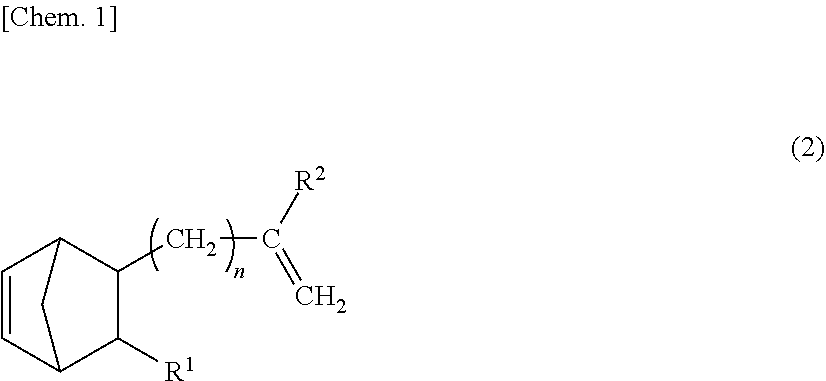Polyolefin rubber composition
- Summary
- Abstract
- Description
- Claims
- Application Information
AI Technical Summary
Benefits of technology
Problems solved by technology
Method used
Image
Examples
example 1
[0078]The following were mixed together in a pressure kneader: 100 parts by weight of an ethylene / propylene / ethylidene norbornene copolymer (Keltan® 2650 from LANXESS), 40 parts by weight of wet silica having a specific surface area of 200 m2 / g (Nipsil LP, from Tosoh Silica Corporation) and 10 parts by weight of SUNPAR 2280 (Japan Sun Oil Co., Ltd.). The following were then added and mixed in: a dimethylpolysiloxane with a degree of polymerization of 30 and having a SiH group at one end of the polymer and a trimethylsiloxy group at the other end, in an amount of 5 parts by weight (an amount such that the number of SiH groups per unsaturated group on the Keltan® 2650 becomes 0.5), and a 1,3-divinyl-1,1,3,3-tetramethyldisiloxane complex of chloroplatinic acid in an amount such that the level of platinum with respect to the Keltan® 2650 becomes 5 ppm. Next, 30 parts by weight of SP-10 (nylon 12 having an average particle size of 10 μm and a melting point of 176° C.; available from Tora...
example 2
[0079]The following were mixed together in a pressure kneader: 100 parts by weight of an ethylene / propylene / ethylidene norbornene copolymer (Keltan® 2650 from LANXESS), 40 parts by weight of wet silica having a specific surface area of 200 m2 / g (Nipsil LP, from Tosoh Silica Corporation) and 10 parts by weight of SUNPAR 2280 (Japan Sun Oil Co., Ltd.). The following were then added and mixed in: a dimethylpolysiloxane with a degree of polymerization of 30 and having a SiH group at one end of the polymer and a trimethylsiloxy group at the other end, in an amount of 5 parts by weight (an amount such that the number of SiH groups per unsaturated group on the Keltan® 2650 becomes 0.5), and a 1,3-divinyl-1,1,3,3-tetramethyldisiloxane complex of chloroplatinic acid in an amount such that the level of platinum with respect to the Keltan® 2650 becomes 5 ppm. Next, 30 parts by weight of LMR (talc having an average particle size of 2 μm and a Mohs hardness of 1; available from Fuji Talc Industr...
example 3
[0080]The following were mixed together in a pressure kneader: 100 parts by weight of an ethylene / propylene / ethylidene norbornene copolymer (Keltan® 2650 from LANXESS), 40 parts by weight of wet silica having a specific surface area of 200 m2 / g (Nipsil LP, from Tosoh Silica Corporation) and 10 parts by weight of SUNPAR 2280 (Japan Sun Oil Co., Ltd.). The following were then added and mixed in: a dimethylpolysiloxane with a degree of polymerization of 30 and having a SiH group at one end of the polymer and a trimethylsiloxy group at the other end, in an amount of 5 parts by weight (an amount such that the number of SiH groups per unsaturated group on the Keltan® 2650 becomes 0.5), and a 1,3-divinyl-1,1,3,3-tetramethyldisiloxane complex of chloroplatinic acid in an amount such that the level of platinum with respect to the Keltan® 2650 becomes 5 ppm. Next, 30 parts by weight of Y-2400 (mica having an average particle size of 9 μm and a Mohs hardness of 2.8; available from Yamaguchi Mi...
PUM
| Property | Measurement | Unit |
|---|---|---|
| Temperature | aaaaa | aaaaa |
| Percent by mass | aaaaa | aaaaa |
| Percent by mass | aaaaa | aaaaa |
Abstract
Description
Claims
Application Information
 Login to View More
Login to View More - R&D
- Intellectual Property
- Life Sciences
- Materials
- Tech Scout
- Unparalleled Data Quality
- Higher Quality Content
- 60% Fewer Hallucinations
Browse by: Latest US Patents, China's latest patents, Technical Efficacy Thesaurus, Application Domain, Technology Topic, Popular Technical Reports.
© 2025 PatSnap. All rights reserved.Legal|Privacy policy|Modern Slavery Act Transparency Statement|Sitemap|About US| Contact US: help@patsnap.com


